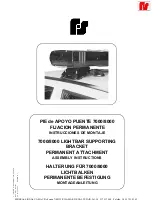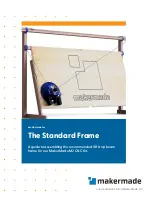
PG7000™ OPERATION AND MAINTENANCE MANUAL
© 1998-2008 DH Instruments, a Fluke Company
Page 190
All Oil Operated Piston-Cylinder Module
Figure 19
. Oil
Piston-Cylinder Module (Expanded View)
Screw the piston-cylinder module into the base of
its bullet case (Acetal shipping and storage case)
and place the base and module on a clean stable
surface with the piston cap up.
Using a 3 mm Allen tool, loosen the two socket
head sleeve retaining screws (5) from the opposing
sides of the main module housing (4).
In reassembly, after the two sleeve retaining screws
(5) are installed, the sleeve (8) must still have a small
amount of freedom to move and rotate within the main
module housing (4).
While firmly holding down the cap (2), use a 5 mm Allen
tool, to loosen the socket head cap retaining screw
(1). Turning the screw pushes the piston head (6)
straight out of the
piston cap (2) ensuring that no sideways force is
applied to the piston (7).
NOTE: Small diameter
pistons can be snapped by excessive sideways
force.
The cap retaining screw will not fully
disengage from the piston cap due to the
adjustment mass (3).
Gently remove the cap and screw from the
assembly. Use caution to be sure the piston head
is out of the cap so as NOT to apply sideways force
to the piston (7) when removing the cap.
When installing the piston cap during reassembly,
remember to reinstall the adjustment mass (3). Take great
care to slip the piston cap (2) straight onto the piston head
(6) and not to apply torque to the piston (7).
Unscrew the main module housing (4) from the
bullet case leaving the piston-cylinder and sleeve
assembly behind in the bullet case base. Carefully
reinstall the piston cap (2) onto the piston head (6)
taking care not to apply sideways torque on the
piston (7). Using the cap as a handle, slide the
piston
straight
out of the cylinder.
NOTE:
Do not
twist the piston or apply sideways force to it. It
can easily be snapped.
Remove the cylinder and sleeve assembly from the
bullet case base. Turn over the assembly and
place it on the sturdy surface with the O-ring
assembly (10) up.
Using a 3 mm Allen tool, loosen the two O-ring
assembly retainer screws (12). The screws are
captive so they will not disengage completely.
Remove the O-ring retainer (11) with the retainer
screws. Remove the O-ring assembly (10).
There are low pressure and high pressure oil piston-
cylinder modules, which are identical except for the size of the
O-ring assembly. The low pressure assembly has a large,
single diameter and is shorter (see
below). In
reassembly, take care to ensure that a low pressure O-ring
assembly is never installed on a high pressure module as
excessive force and damage under pressure could result.
Holding the cylinder (9) in the open end of the
cylinder sleeve (8), turn the cylinder sleeve over.
Allow the cylinder to gently slide out. The end of
the cylinder marked with the serial number must
enter the module housing first.
The sleeve retaining screws (5) MUST be reinstalled
before pressure is applied to the piston-cylinder module.
Damage to equipment and injury to personnel may result
from pressurizing the piston-cylinder module without the sleeve
retaining screws installed.
Continued on next page --->
Содержание PG7000
Страница 10: ...PG7000 OPERATION AND MAINTENANCE MANUAL 1998 2008 DH Instruments a Fluke Company Page VIII N NO OT TE ES S ...
Страница 44: ...PG7000 OPERATION AND MAINTENANCE MANUAL 1998 2008 DH Instruments a Fluke Company Page 34 N NO OT TE ES S ...
Страница 182: ...PG7000 OPERATION AND MAINTENANCE MANUAL 1998 2008 DH Instruments a Fluke Company Page 172 N NO OT TE ES S ...
Страница 210: ...PG7000 OPERATION AND MAINTENANCE MANUAL 1998 2008 DH Instruments a Fluke Company Page 200 N NO OT TE ES S ...
Страница 214: ...PG7000 OPERATION AND MAINTENANCE MANUAL 1998 2008 DH Instruments a Fluke Company Page 204 N NO OT TE ES S ...
Страница 224: ...PG7000 OPERATION AND MAINTENANCE MANUAL 1998 2008 DH Instruments a Fluke Company Page 214 N NO OT TE ES S ...
















































